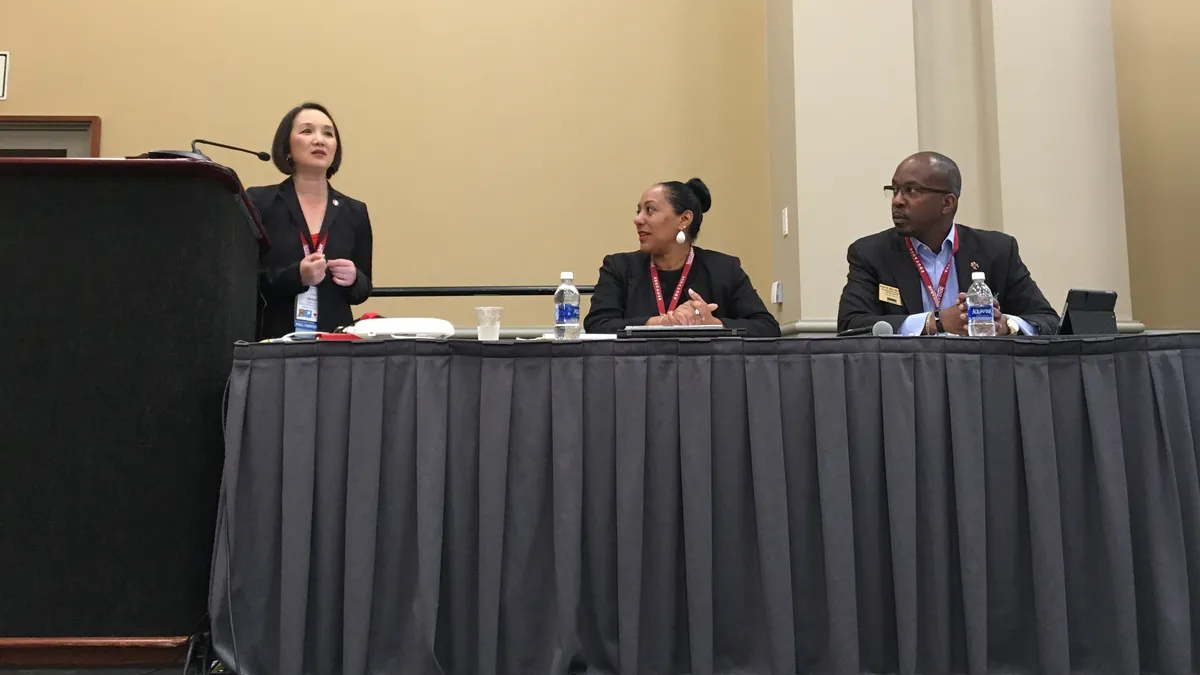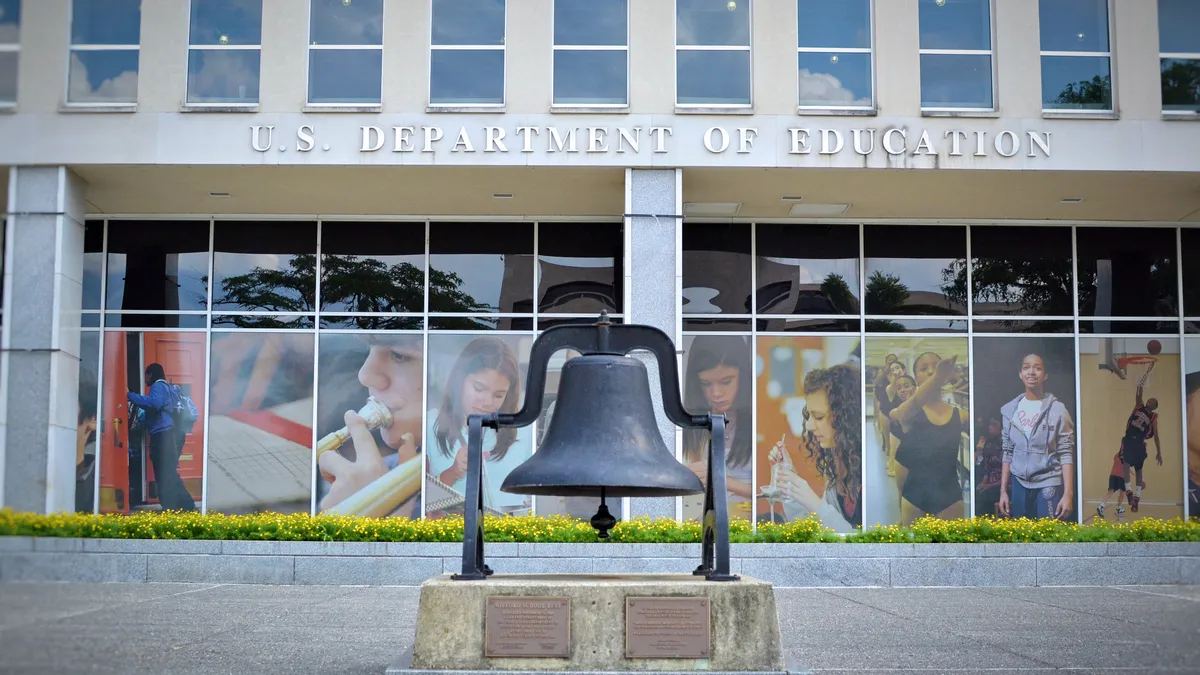During an early morning session at last week's annual Educause conference in Philadelphia, two CIOs and chief diversity officer detailed strategies for developing and maintaining a diverse and inclusive campus IT workforce. Over the course of 90 minutes, Stony Brook University CIO Melissa Woo, University of Richmond CIO Keith McIntosh, and Yale University Chief Diversity Officer Deborah Stanley-McAulay shared stories of their failures as well as successes, with the crowd growing larger as the meeting continued.
McIntosh opened by saying that the topic is something he’s very passionate about, noting that at his first Educause in Anaheim several years ago, he felt like it was a sea of white people. On his efforts to try and meet up with Woo at that show, they joked, “How hard can it be for an Asian woman to find a black man in a sea of white people?”
Stanley-McAulay says she met Mac last year when Educause was once again in Anaheim and had a similar experience in trying to find him. However, she gave kudos to the organization for embracing diversity and inclusion and making them a real and meaningful public conversation, adding that she feels the commitment to the conversation will continue beyond this year's show.
(Indeed, the evening before the first day of the conference, Education Dive caught up with Educause President John O'Brien, who told us there was a conscious effort underway to devote more time and attention to these issues, as filling the gaps in the higher ed IT workforce is a step toward improving the situation for IT at large.)
Stanley-McAulay went on to say that higher ed thinks about four gateways: students, faculty, staff, and alums. And as a diversity and inclusion (or D&I) practitioner, champion or ally, you can’t see boundaries between those groups. Administrators must think deeply about how to work with each of those groups and then ask how you can address their concerns or needs.
Woo said that the trio wanted to give people attending the session tools that they could take back to their campus. “People don’t like to be lectured at and I don’t like to give people a guilt trip along those lines,” Woo said, adding that you only have to make it clear that diversity and inclusion are needed and give people the tools to do it.
Recruiting for diversity without effective retention is like trying to fill a leaky bucket
Early on, Woo shared a failure story from her first managerial job in a group of Unix system administrators. Her very first hire, she said, was a woman whose background seemed like she had a lot of grit and a lot of experience. Unfortunately, however, that woman ended up being "toxic" to the entire group, who were all males aside from her and Woo. Woo said the experience taught her the difference between equality and equity, adding that she could have done a better job of making it a better environment for her.
McIntosh said that everywhere he goes, he tries to be inclusive with his team members. At Ithaca College, they were very siloed when he arrived. The architecture was behind, and a lot of heavy lifting was needed to take the campus in the right direction. He was trying to find a very succinct way of creating a 1-to-2-page document that briefly framed what they were trying to do, and he had a junior team member who took it upon herself to do so on her own that night. And it was all because she was included in those conversations.
Stanley-McAulay said that she never uses the word “expert” to describe herself because she’s as much on her D&I journey as everyone else is. At Yale, they’re trying to move toward being inclusive by increasing minorities in managerial and professional positions. They looked at retention, recruitment and turnover data for minority populations, finding that those turnover numbers were particularly high for young professionals.
They needed to stop that leak, and one way they made a commitment to do so was by creating “affinity groups,” or smaller communities within the organization. In talking with each other, those groups share their best and worst examples of working at Yale. They created a young professionals group three years ago, which Stanley-McAulay said is the most aggressive, boldest group and is always working to be at the table to help solve problems.
What tools are available to administrators?
Woo asked Stanley-McAulay about zero-tolerance policies regarding incidents. Yale doesn’t have a zero tolerance policy, but Stanley-McAulay said that has been an ongoing discussion. She mentions freedom of speech, noting that she believes students and faculty have that freedom, particularly regarding public protest of incidents, but staff don't. But she also said she wants to be sure the organization does due diligence on any incident that occurs before a decision is made.
The conversation shifted to being a diversity and inclusion ally and respectfully calling out incidents when people are inappropriate. McIntosh said he heard something from someone that really stood out to him: “Excuse me? What did you just say? Can you say that to me one more time so I can be sure I heard what I think you just said?”
The awkwardness created by that response isn’t intended to be demeaning, but it can start a conversation about what was said.
Stanley-McAulay mentioned that she teaches a few workshops, including one titled “Mutual Respect in the Workplace,” noting that many individuals aren’t equipped to have a dialog and just want behavior to stop.
McIntosh asked about the best ways to share and get others to be more comfortable with the topic.
Woo said that inclusivity can be boosted by highlighting the variety of paths to IT. This prompted McIntosh to talk about restructuring his team at Ithaca and how he reorganized around the hard and soft disciplines in IT. He saw that many of the softer disciplines tended to have more women, but he wanted to find more diverse applicants for the harder disciplines. He’s doing that at the University of Richmond now. Says they’re now hiring an African-American female information security officer.
Stanley-McAulay said that, at Yale, every open management position has to have 25% of the pool be minority applicants. It took a couple of years to reach that standard and a shift in the mindset of managers and staffing reps, but they did it.
Recognizing unconscious bias, she said, is an inclusionary practice that also should be put into place. Yale’s police force, for example, has about 100 officers. In a recent round of hiring, the chief was clear that he wasn’t looking for veteran officers who wanted a second career at Yale. He wanted a diverse pool around race, gender and other factors that can be ascertained. She said that, on notepads, she used the red margin to track her biases in each interview during the recruitment process.
When she reviewed what she had written, she realized she kept writing notes on age during the interviews, adding that she talked to the chief afterwords and wanted to make sure the biases she noted didn’t hinder the recognition of talent and aptitude in the hiring decisions.
Stanley-McAulay also noted that when speaking up, you’re exposing vulnerabilities and you must trust each other to check one another on your own biases.
Woo added that it's important to look at, and to teach and build, the soft skills around things like communication and collaboration as much as the technical skills. In many cases, managers may need to rethink what a “best candidate” is because there are such narrow definitions in our heads of what a “best candidate” is. McIntosh chimed in that those narrow descriptions made the search process at Ithaca more difficult during its reorganization.
Of course, geography and local issues can make hiring for diversity and inclusion more difficult.
Stanley-McAulay discussed how New Haven’s former status as “murder capital of the U.S.” made recruitment and retention difficult at one point. Human resources partnered with the school’s “town and gown affairs” organization to develop a housing initiative for recruitment. And she said that in come cases, you might also find you need to create some communities.
Thought about your strategy should be plotted over the next 10 years. You have to think long-term and about the legacy you’re leaving when you plan these strategies. Part of diversity is rebranding your organization, and you get to determine what that brand looks like. Branding conversations must happen internally before they go externally. She advised that leaders be transparent about where they are today, where they aspire to be, and the work needed to get there.


















